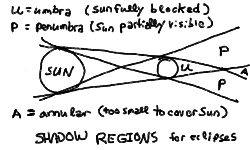
Seeds: Chapter 3
Next Lecture - Solar Eclipses and Early Greek Astronomy
The shadow cast by an opaque screen in front of a point-like light source is always sharp. However, the shadow cast by a body eclipsing an extended light source like the Sun is "fuzzy". There is a region surrounding the dark inner shadow that is not as dark - from those points looking back toward the light the screen only partly covers the light. This is called the penumbra, and is distinguished from the dark inner shadow, or umbra.
Experiment: try looking at the shadow of your hand on a wall on a sunny day.

The umbra of the Earth is a cone that extends 1.4 x 10^6 km anti-sunward. The Moon's orbit intersects this 27% of the way along, and at this point the umbra is around 2.7 times the Moon's diameter in cross-section.
The umbra of the Moon extends only around 383000 km, compared to its distance from the Earth of 384000 km. Only when the Moon is at perigee and is closest to the Earth in its elliptical orbit can a total solar eclipse occur. If it is more distant, the umbra falls short of the Earth's surface and the Moon is smaller than the Sun in angular size. During a full eclipse the Sun is seen in a ring or annulus around the edge of the Moon --- thus this is know as an annular eclipse.
Go to Previous Lecture ---- Go to Next Lecture
Back to the Lecture Notes Index
Back to the ASTR001/Sec3 Page
Steven T. Myers - Last revised 03May96